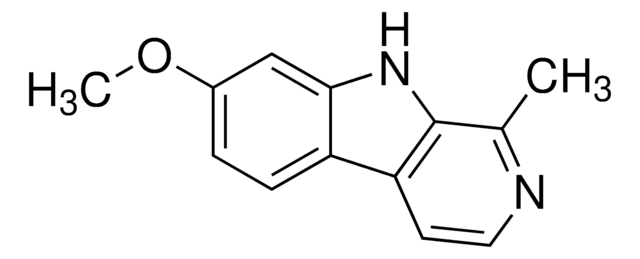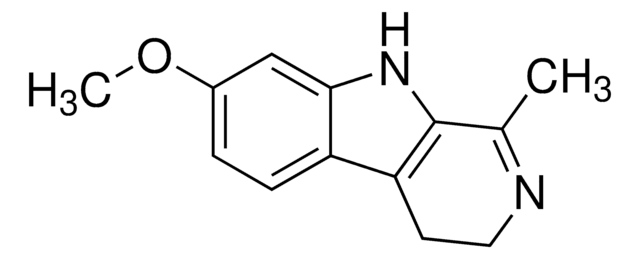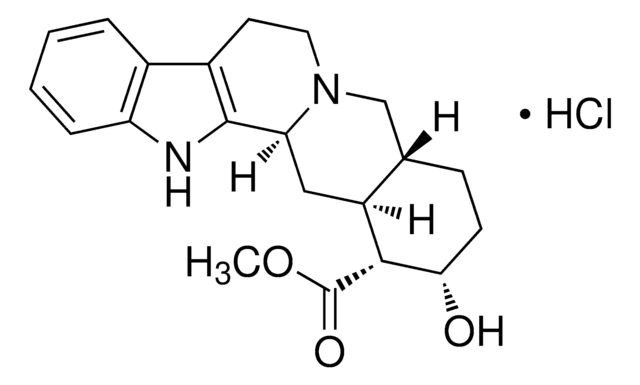51330
Harmaline
≥95%
Synonyme(s) :
1-Methyl-7-methoxy-3,4-dihydro-β-carboline, 3,4-Dihydroharmine, 4,9-Dihydro-7-methoxy-1-methyl-3H-pyrido[3,4-b]indole, Dihydroharmine, Harmalol methyl ether, Harmidine, NSC 407285
About This Item
Produits recommandés
Pureté
≥95%
Forme
powder
Contrôle du médicament
regulated under CDSA - not available from Sigma-Aldrich Canada
drug control
stupéfiant (France); regulated under CDSA - not available from Sigma-Aldrich Canada
Pf
232-234 °C (lit.)
Chaîne SMILES
COc1ccc2c3CCN=C(C)c3[nH]c2c1
InChI
1S/C13H14N2O/c1-8-13-11(5-6-14-8)10-4-3-9(16-2)7-12(10)15-13/h3-4,7,15H,5-6H2,1-2H3
Clé InChI
RERZNCLIYCABFS-UHFFFAOYSA-N
Informations sur le gène
human ... ADRA1A(148) , ADRA1B(147) , ADRA2A(150) , ADRA2B(151) , ADRA2C(152) , ADRB1(153) , ADRB2(154) , CHRM1(1128) , CHRM2(1129) , CHRM3(1131) , CHRM4(1132) , CHRM5(1133) , DRD1(1812) , DRD5(1816) , HTR1A(3350) , HTR1B(3351) , HTR1D(3352) , HTR2C(3358) , HTR3A(3359) , HTR5A(3361) , HTR6(3362) , HTR7(3363) , SLC6A2(6530) , SLC6A4(6532) , SLC9A2(6549) , SLC9A5(6553)
rat ... Drd2(24318) , Drd3(29238) , Drd4(25432) , Htr2a(29595) , Maoa(29253) , Maob(25750) , Slc9a1(24782) , Slc9a3(24784)
Vous recherchez des produits similaires ? Visite Guide de comparaison des produits
Application
- Acylated harmalines via Friedel-Crafts reaction
- Phenacyl derivatives of 1-methyl-7-methoxy-β-carbolines as central nervous system affectors
- Palladium harmaline DMSO chloro complex as anti-tumor agent
Natural product scaffold in preparation of:
- Trypanothione reductase inhibitors†
Actions biochimiques/physiologiques
Mention d'avertissement
Warning
Mentions de danger
Conseils de prudence
Classification des risques
Acute Tox. 4 Oral - STOT SE 2
Organes cibles
Central nervous system
Code de la classe de stockage
11 - Combustible Solids
Classe de danger pour l'eau (WGK)
WGK 3
Point d'éclair (°F)
Not applicable
Point d'éclair (°C)
Not applicable
Équipement de protection individuelle
Eyeshields, Gloves, type N95 (US)
Faites votre choix parmi les versions les plus récentes :
Déjà en possession de ce produit ?
Retrouvez la documentation relative aux produits que vous avez récemment achetés dans la Bibliothèque de documents.
Les clients ont également consulté
Notre équipe de scientifiques dispose d'une expérience dans tous les secteurs de la recherche, notamment en sciences de la vie, science des matériaux, synthèse chimique, chromatographie, analyse et dans de nombreux autres domaines..
Contacter notre Service technique



![Benzo[a]pyrène ≥96% (HPLC)](/deepweb/assets/sigmaaldrich/product/structures/253/820/be96d879-1811-46c0-8f11-612019691c2d/640/be96d879-1811-46c0-8f11-612019691c2d.png)





